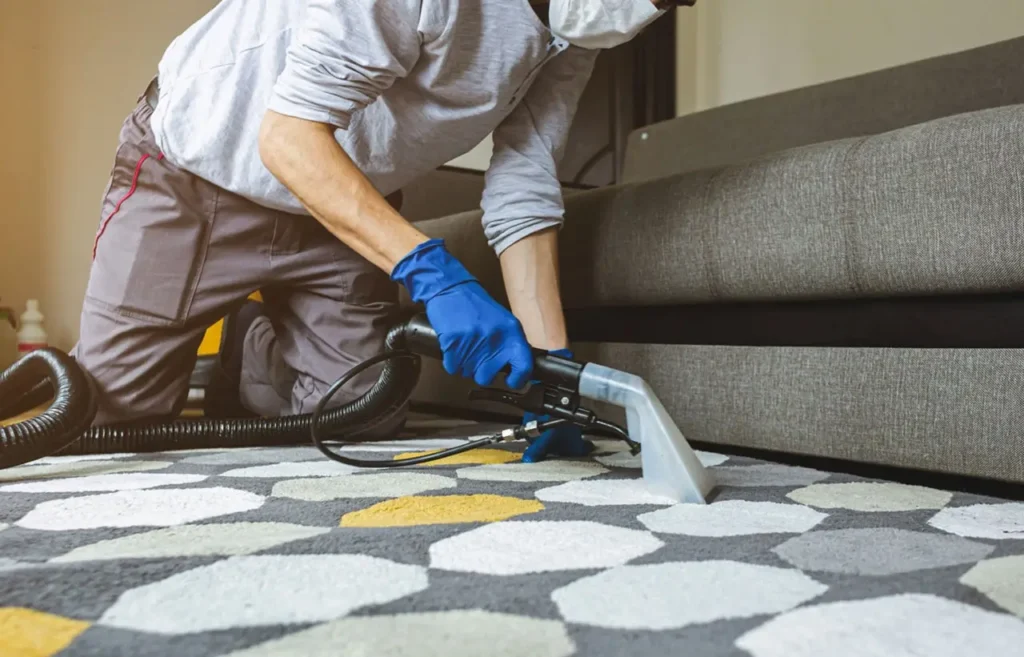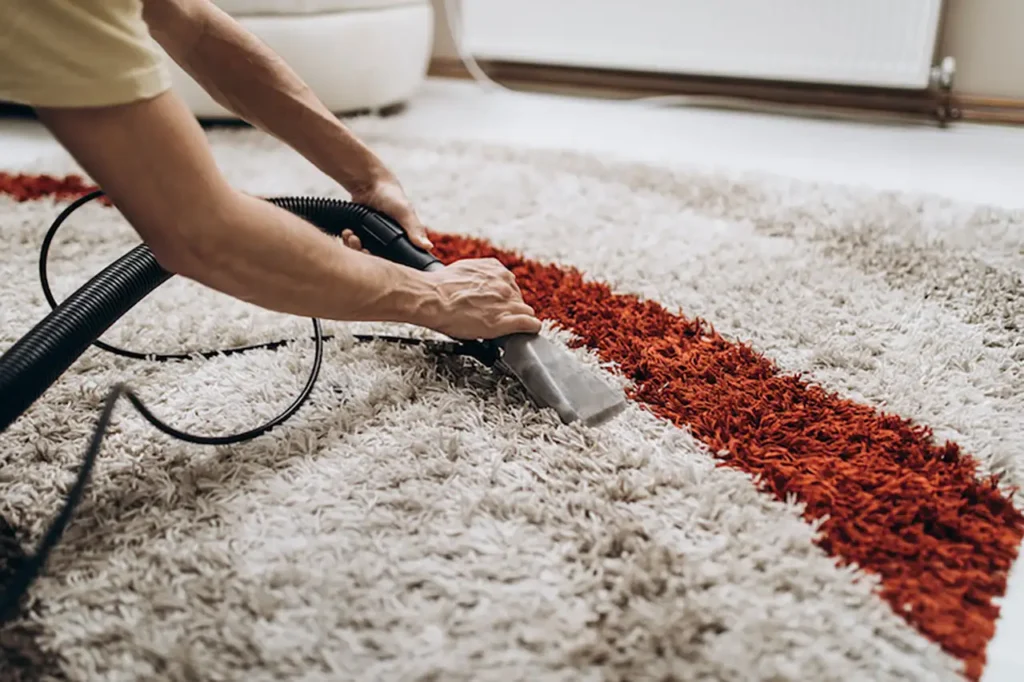Carpet drying time in the UK typically ranges from 6 to 12 hours, but this can vary based on weather, carpet type, and cleaning method. After a professional cleaning, homeowners often wonder how long they need to wait before walking on or replacing furniture. Factors such as ventilation, humidity, and fibre density all influence how quickly carpets dry.
In this guide, you’ll learn the average drying times across the UK, how winter weather affects the process, and expert tips to help speed up carpet drying safely and effectively.
Average Carpet Drying Time After Cleaning
On average, carpets in the UK take 6 to 12 hours to dry fully after a professional cleaning. However, this can range from as little as 2 hours for low-moisture cleaning methods to 24 hours for heavy, deep-cleaned wool carpets.
Here’s a quick reference for different cleaning methods:
Cleaning Method | Average Drying Time | Notes |
Dry Carpet Cleaning | 1–2 hours | Minimal water use; fastest drying method |
Bonnet or Encapsulation Cleaning | 2–4 hours | Ideal for commercial carpets; quick turnaround |
Hot Water Extraction (Steam Cleaning) | 6–12 hours | Most common method for deep cleaning homes |
Heavy Steam Cleaning (High Moisture) | 12–24 hours | Effective for heavily soiled or wool carpets |
Professional cleaners typically leave carpets slightly damp, not soaked. The fibres retain some moisture that needs time to evaporate. In modern homes with good airflow and heating, the average living room carpet is walkable within 6–8 hours.
That said, winter conditions can significantly extend this time frame. In London and other humid regions of the UK, drying may take closer to 12–18 hours, especially in rooms with limited ventilation.
How Long for Carpets to Dry After Cleaning in London
London homes, particularly those in flats or older buildings, often experience slower carpet drying times due to restricted airflow and higher indoor humidity.
If your carpet was cleaned using hot water extraction, expect drying to take around 10 to 16 hours, depending on the following:
- Room size and ventilation
- Indoor temperature and humidity levels
- Whether windows or fans are used
- Carpet thickness and fibre type
Using a dehumidifier or oscillating fan after cleaning can reduce drying time by several hours. Professional London-based cleaning companies often recommend turning on central heating for 30–60 minutes after the service to circulate warm air and speed evaporation.
Wool Carpet Drying Time
Wool is a natural fibre known for its absorbency and softness — but that same quality means it holds more water than synthetic carpets. As a result, wool carpet drying time typically ranges between 12 and 24 hours.
Because wool fibres are denser and retain moisture deep within their structure, drying depends heavily on airflow and temperature. Leaving windows slightly open or using gentle heat helps moisture escape faster without damaging the carpet backing.
If your carpet remains damp after 24 hours, it’s best to contact your cleaning company for advice — prolonged moisture can encourage mould growth or unpleasant odours.

Factors That Affect Carpet Drying Time
Several elements influence how long it takes for your carpets to dry completely. Understanding these helps you estimate drying time more accurately and take proactive steps to speed it up.
1. Cleaning Method
The type of cleaning method used is the biggest factor.
- Dry cleaning and encapsulation use very little water, meaning carpets can be ready within a couple of hours.
- Steam cleaning or hot water extraction saturates the fibres more deeply, so drying takes longer but results in a more thorough clean.
2. Type of Carpet Fibre
Each carpet material reacts differently to moisture:
Carpet Fibre Type | Typical Drying Time | Key Notes |
Nylon or Polyester | 4–6 hours | Dries quickly; repels water well |
Wool | 12–24 hours | Absorbs more water; slower to dry |
Olefin (Polypropylene) | 3–5 hours | Resistant to moisture; quick-drying |
Blends (Wool/Synthetic Mix) | 6–12 hours | Varies depending on fibre ratio |
Natural fibres like wool or cotton require more drying time, while synthetics are faster due to their water-resistant properties.
3. Indoor Temperature and Humidity
The UK’s variable climate plays a major role in drying speed.
- In summer, warm air and open windows allow faster evaporation — often within 6 hours.
- In winter, cold air holds less moisture, slowing down evaporation; drying can take up to 18–24 hours without ventilation.
If you’re drying carpets in colder months, maintaining an indoor temperature around 20–22°C significantly helps.
4. Air Circulation and Ventilation
Carpets dry faster when air circulates freely. Open doors and windows to create a cross-breeze, or use fans to keep air moving.
In closed flats or rooms without natural airflow, consider using a dehumidifier to remove excess moisture from the air.
5. Carpet Thickness and Pile Height
Thick, high-pile carpets trap more moisture and therefore dry more slowly than low-pile or loop designs. Deep fibres hold water in their base layers, where airflow is limited.
If your carpet has a dense pile, expect an extra 3–5 hours of drying time.
6. Level of Soiling and Cleaning Intensity
Heavily soiled carpets require more water and multiple extraction passes, which naturally increases drying time. If your cleaner applied stain treatments or sanitising sprays, this may also extend the process slightly.
7. Season and Weather Conditions
During winter or rainy periods, humidity levels in the UK rise significantly, especially in London and coastal areas. This slows evaporation and may cause carpets to stay damp for longer than expected. On dry, breezy days, carpets can dry in nearly half the time.

How to Speed Up Carpet Drying
If you want your carpets to dry faster, a few simple adjustments can make a big difference. Whether you’ve had steam cleaning, hot-water extraction, or a light surface wash, following these steps will help reduce moisture retention and prevent odours or mould growth.
1. Increase air circulation
Open windows and doors to create cross-ventilation. Fresh airflow is one of the most effective ways to lower drying time naturally.
2. Use fans or air movers
Position portable fans toward damp areas. In professional settings, technicians use high-velocity air movers to speed up evaporation within hours.
3. Turn on the heating
During cold or humid weather, central heating helps maintain a consistent temperature that promotes faster drying, especially in winter months.
4. Use a dehumidifier
Dehumidifiers remove moisture from the air, reducing the relative humidity and allowing carpets to dry evenly.
5. Avoid replacing furniture too early
Wait until carpets are completely dry before placing heavy furniture back. Damp fibres can trap moisture underneath, leading to mildew or odour.
6. Lift the carpet edges if necessary
In rare cases of heavy soaking, gently lift edges to let air reach the underlay — but only if it’s safe and the carpet isn’t glued down.
7. Clean regularly
Regular maintenance means less dirt and water are required during deep cleaning, resulting in shorter drying times overall.
How Long Does It Take Different Surfaces to Dry?
Not all carpet materials dry at the same rate. Fibre composition, pile density, and cleaning method all play a role. Here’s a quick comparison:
Carpet or Surface Type | Typical Drying Time (carpet drying time UK) |
Synthetic carpets (nylon, polyester) | 4–8 hours |
Wool carpets | 8–24 hours |
Commercial low-pile carpets | 2–6 hours |
Rugs and mats | 3–6 hours |
Underlay or padding (if wet) | Up to 48 hours |
Hard floors (laminate, tile, vinyl) | 1–2 hours after cleaning |
Tip: Wool and thick-pile carpets take longer to dry due to their natural fibres and density. Use fans or dehumidifiers to help them dry evenly, especially in colder months.
How to Know When Your Carpet Is Fully Dry
Knowing exactly when your carpet is completely dry is essential for both hygiene and longevity. A carpet that still retains moisture can quickly develop unpleasant odours, attract dirt, or even lead to mould growth beneath the surface. Here’s how to tell if it’s ready for regular use:
- The touch test
Gently press your palm against the carpet fibres. If it feels cool, slightly damp, or sticky, it’s not yet dry. A dry carpet feels neutral in temperature and soft underhand. - Check the odour
A musty or earthy smell means moisture is still present. Freshly cleaned and dried carpets should smell clean and neutral, with no damp scent at all. - Inspect the underlay
If possible, lift a corner of the carpet and touch the underlay or padding. These layers take the longest to dry, especially after steam or hot-water extraction cleaning. - Look for texture consistency
When completely dry, carpet fibres regain their natural bounce and uniform colour tone. Damp patches often appear slightly darker or matted down. - Monitor the time
On average, carpets are fully dry within 6–12 hours under normal UK conditions, but wool or thick-pile carpets may need up to 24 hours, especially in winter or poorly ventilated spaces.
Conclusion: Keeping Carpets Fresh, Clean, and Dry
Understanding carpet drying time is just as important as the cleaning process itself. On average, most carpets in the UK take between 6 and 12 hours to dry, but several factors — such as fibre type, weather, and ventilation — can extend this period. With a few smart steps like using fans, dehumidifiers, and keeping rooms warm, you can significantly shorten the drying time and prevent moisture-related issues.
If your carpet still feels damp after a full day or you notice persistent odours, it’s best to contact a professional carpet cleaning company in London. Trained technicians can assess airflow, humidity, and fibre type to ensure safe and complete drying — helping you enjoy a cleaner, healthier home in no time.
FAQ About Carpet Drying Time
Ideally, wait at least 6 hours before walking on the carpet, and up to 24 hours for deep steam-cleaned areas. If you must step on it, wear clean socks to avoid re-soiling.
Yes, but allow enough ventilation. Avoid placing bedding or mattresses directly on damp floors, and keep windows slightly open for airflow.
Prolonged moisture can lead to mould growth, unpleasant smells, and fibre damage. If the carpet still feels wet after 24 hours, use a dehumidifier or contact your cleaning company for support.
Absolutely. Low temperatures and high humidity significantly extend winter carpet drying time. Use heating and fans to maintain consistent airflow.
It can happen with thick wool or heavily soiled carpets. However, if dampness persists beyond a day, take steps to increase ventilation or consult a professional to check for trapped moisture.

